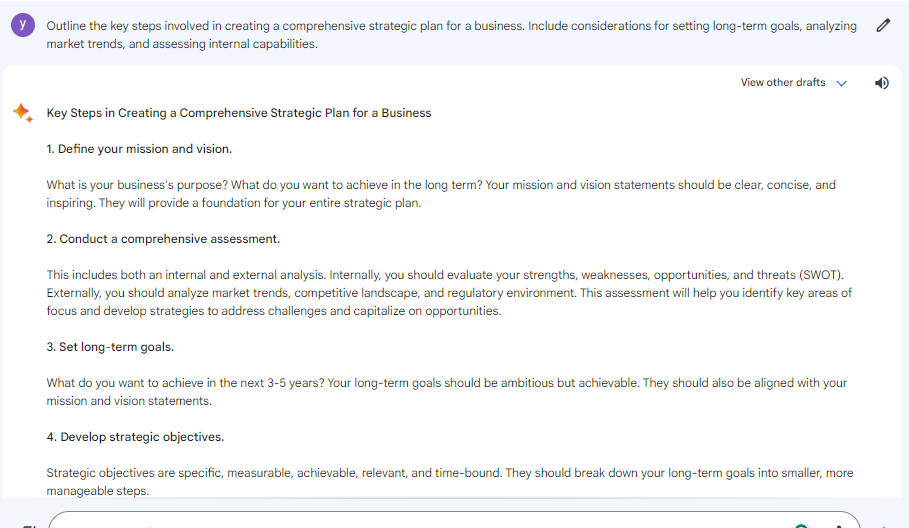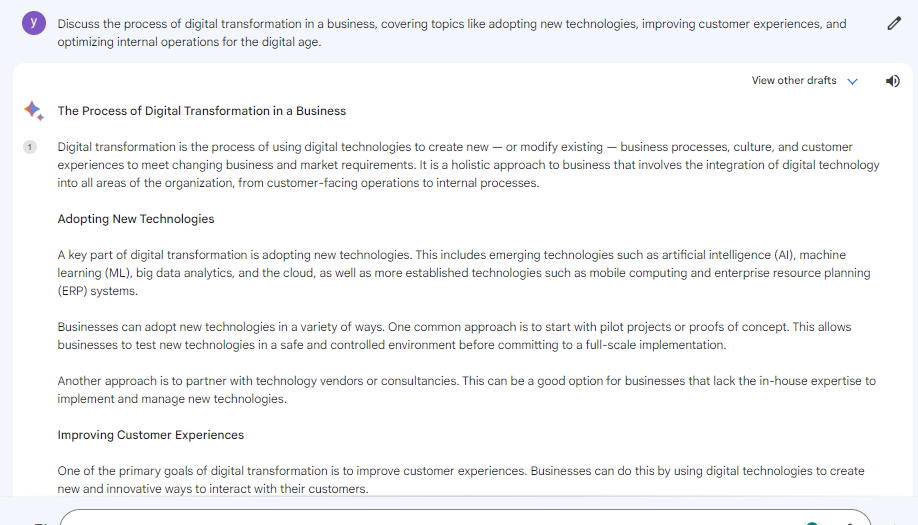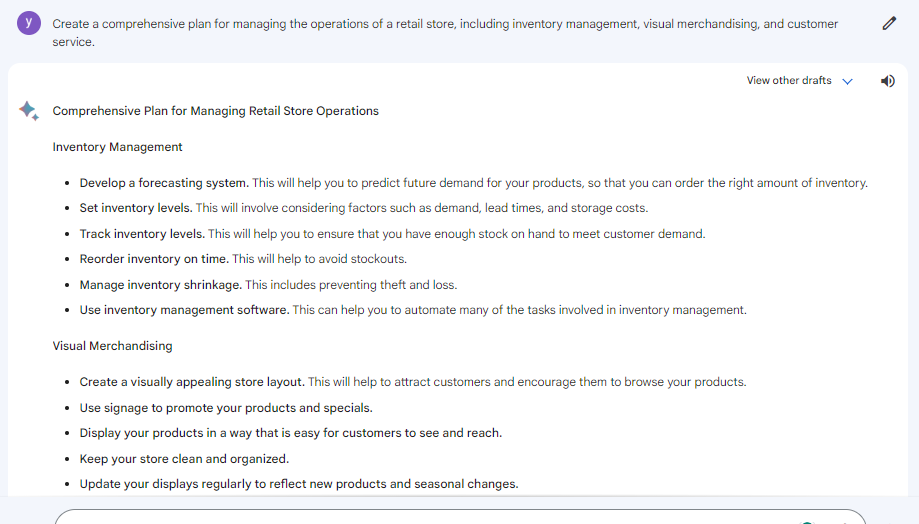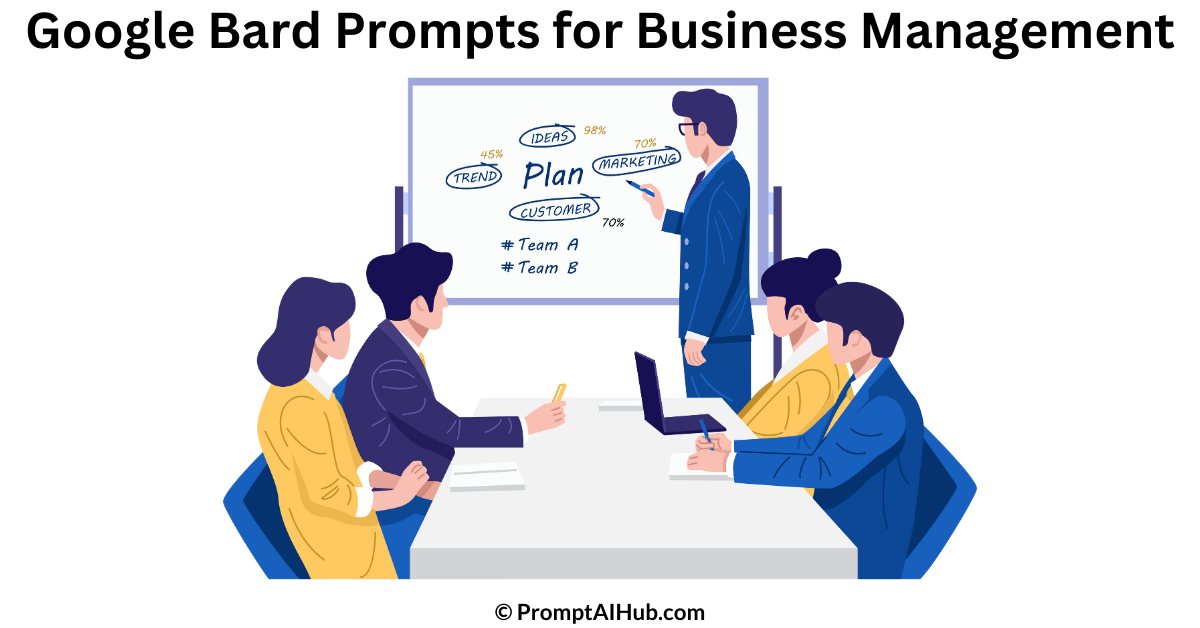“Google Bard Prompts for Business Management” – If you’re looking to navigate the dynamic world of business management more effectively, you’re in the right place. In just a few minutes, you’ll discover how to harness the power of Google Bard prompts to enhance your business management skills and decision-making. Stick around to unlock the tools that can redefine your approach to management.
Also Visit: 141 Tested Google Bard Prompts For Marketing – Boost Productivity
All Google Bard Prompts for Business Management
1. Strategic Planning: Outline the key steps involved in creating a comprehensive strategic plan for a business. Include considerations for setting long-term goals, analyzing market trends, and assessing internal capabilities.

2. Organizational Structure: Describe the various types of organizational structures (functional, divisional, matrix, etc.) and discuss the factors that influence the choice of structure for a specific business.
3. Leadership and Management Styles: Compare and contrast different leadership and management styles, such as autocratic, democratic, transformational, and transactional. Explain when and how each style is most effective.
4. Change Management: Provide a step-by-step guide to implementing successful change management within an organization. Discuss the importance of communication, employee engagement, and measuring the impact of change.
5. Financial Management: Explain the key principles of financial management, including budgeting, forecasting, and financial analysis. Provide examples of financial metrics and KPIs used for decision-making.
6. Human Resource Management: Describe the critical aspects of human resource management, including recruitment, training, performance evaluation, and employee retention strategies. Discuss the importance of diversity and inclusion in the workplace.
7. Marketing Strategy: Develop a comprehensive marketing strategy for a new product or service, including market research, target audience analysis, pricing, promotion, and distribution channels.
8. Supply Chain Management: Detail the steps involved in optimizing a supply chain for efficiency and cost-effectiveness. Discuss the role of technology in supply chain management and strategies for mitigating supply chain risks.
9. Quality Management: Explain the principles of Total Quality Management (TQM) and how it can be implemented in a business to enhance product or service quality. Discuss the role of quality standards and continuous improvement.
10. Risk Management: Create a risk management plan for a business, identifying potential risks (financial, operational, market, etc.) and outlining strategies to mitigate or manage these risks. Discuss the role of insurance and contingency planning.
Also Visit: 31 Effective Google Bard Prompts For Resume Writing – That Will Help You Land Your Dream Job
11. Project Management: Explain the key components of effective project management, including defining project scope, setting objectives, creating a project schedule, and managing resources. Discuss popular project management methodologies.
12. Customer Relationship Management (CRM): Describe the importance of CRM in business. Discuss the benefits of implementing CRM software and strategies for building and maintaining strong customer relationships.
13. Business Ethics and Corporate Social Responsibility: Discuss the ethical considerations businesses should account for and how corporate social responsibility initiatives can benefit a company’s reputation and bottom line.
14. Market Entry Strategies: Compare and contrast different market entry strategies for international expansion, such as exporting, licensing, franchising, joint ventures, and wholly-owned subsidiaries.
15. Performance Metrics and Key Performance Indicators (KPIs): Identify essential performance metrics and KPIs for different business functions, like sales, marketing, and operations. Explain how they contribute to performance evaluation.
16. Negotiation and Conflict Resolution: Offer a step-by-step guide to effective negotiation techniques and conflict resolution strategies in a business context. Discuss the importance of win-win solutions.
17. Innovation Management: Outline strategies for fostering innovation within an organization, including idea generation, product development, and managing intellectual property. Explain the role of innovation in maintaining competitiveness.
18. Financial Forecasting: Explain the importance of financial forecasting for businesses. Provide a detailed process for creating financial forecasts, including sales forecasts, cash flow projections, and budgeting.
19. Crisis Management: Develop a crisis management plan that covers strategies for handling various business crises, from natural disasters to reputation management in the age of social media.
20. Digital Transformation: Discuss the process of digital transformation in a business, covering topics like adopting new technologies, improving customer experiences, and optimizing internal operations for the digital age.

21. Business Continuity Planning: Describe the elements of a robust business continuity plan, including risk assessment, data backup, and disaster recovery. Explain how such plans help maintain business operations during unexpected disruptions.
22. Strategic Alliances and Partnerships: Explain the benefits and challenges of forming strategic alliances and partnerships with other organizations. Provide examples of successful partnerships and their impact on business.
23. Market Research and Competitive Analysis: Detail the steps involved in conducting effective market research and competitive analysis. Discuss methods for gathering data and interpreting findings.
24. Inventory Management: Discuss inventory management techniques to optimize supply chain efficiency. Explain the role of just-in-time inventory systems, ABC analysis, and safety stock.
25. Employee Development and Training: Develop a plan for employee development and training within a company. Discuss the benefits of ongoing training and strategies for enhancing employee skills.
26. Global Expansion Strategies: Outline a comprehensive strategy for a business looking to expand globally. Address key considerations, including cultural differences, legal and regulatory issues, and market entry.
27. Sustainability and Environmental Responsibility: Explain the role of sustainability in business operations and the benefits of adopting environmentally responsible practices.
28. Brand Management: Discuss the fundamentals of brand management, including brand identity, positioning, and reputation management. Provide examples of companies with strong brand management strategies.
29. E-commerce and Online Retail: Create a plan for starting or enhancing an e-commerce business, covering aspects like website design, payment processing, and digital marketing.
30. Succession Planning: Explain the importance of succession planning for business continuity. Discuss strategies for identifying and developing future leaders within the organization.
Also Visit: 37 Best Free Chrome Extensions For Google Bard (Tried & Tested)
31. Cost Management and Cost Reduction: Develop a cost management strategy for a business, including cost control measures and cost reduction techniques. Discuss the importance of cost management in improving profitability.
32. Intellectual Property and Patent Strategy: Explain the significance of intellectual property rights and patent protection for businesses. Describe the process of filing and managing patents to safeguard innovation.
33. Sales and Distribution Channel Strategy: Create a sales and distribution channel strategy for a product or service. Discuss the advantages and disadvantages of various distribution channels, such as direct sales, wholesalers, and e-commerce.
34. Mergers and Acquisitions (M&A): Outline the steps involved in the M&A process, from target identification and due diligence to post-merger integration. Discuss the potential benefits and risks of M&A activities.
35. Employee Engagement and Productivity: Develop an employee engagement and productivity improvement plan, including strategies for boosting morale, motivation, and overall performance.
36. Lean Management and Six Sigma: Explain the principles of lean management and Six Sigma methodologies. Provide examples of how these techniques can be applied to streamline processes and reduce waste.
37. Customer Segmentation and Targeting: Discuss the importance of customer segmentation and targeting in marketing. Create a segmentation plan for a specific product or service and outline strategies for reaching each segment effectively.
38. Market Analysis and Competitive Intelligence: Describe the process of conducting a thorough market analysis and gathering competitive intelligence. Explain how these insights can inform strategic decision-making.
39. Stakeholder Management: Identify key stakeholders in a business and develop a stakeholder management plan. Discuss strategies for building and maintaining positive relationships with stakeholders.
40. Retail Store Operations: Create a comprehensive plan for managing the operations of a retail store, including inventory management, visual merchandising, and customer service.

41. Economic Analysis and Business Forecasting: Discuss the importance of economic analysis for businesses and provide a guide to conducting economic forecasts. Explain how economic factors impact business decisions.
42. Knowledge Management: Explain the significance of knowledge management in organizations. Outline strategies for capturing, storing, and sharing knowledge effectively within a company.
43. Customer Retention Strategies: Develop a customer retention strategy for a business. Discuss the role of customer loyalty programs, feedback mechanisms, and personalized services in retaining customers.
44. Sourcing and Procurement Management: Describe the process of sourcing and procurement, including supplier selection, negotiation, and contract management. Discuss strategies for optimizing procurement operations.
45. Brand Expansion and Diversification: Create a plan for expanding or diversifying a brand into new product lines or markets. Discuss the risks and rewards of brand extension.
46. Employee Compensation and Benefits: Outline an employee compensation and benefits package that attracts and retains top talent. Discuss various compensation structures, from salary to stock options.
47. Business Exit Strategies: Explain different exit strategies for business owners, such as selling the company, passing it on to family, or going public. Discuss the factors that influence the choice of an exit strategy.
48. Data Analytics and Business Intelligence: Describe the role of data analytics and business intelligence tools in making data-driven decisions. Provide examples of how businesses can leverage data to gain a competitive advantage.
49. Digital Marketing Strategy: Develop a comprehensive digital marketing strategy, including SEO, content marketing, social media, and paid advertising. Discuss key performance indicators (KPIs) for digital marketing campaigns.
50. Franchise Development and Management: Outline the steps involved in franchising a business and managing a franchise network. Discuss the legal and operational aspects of franchising.
Also Visit: 25 Best Google Bard Prompts For Business Ideas – Effortless Business Ideation
51. Customer Feedback and Improvement: Explain how businesses can effectively gather and utilize customer feedback for continuous improvement. Discuss strategies for turning customer feedback into actionable insights.
52. Government Regulations and Compliance: Describe the impact of government regulations on businesses and the importance of compliance. Provide a guide to staying updated on regulatory changes and adapting business operations accordingly.
53. Strategic Outsourcing: Discuss the benefits and challenges of strategic outsourcing for businesses. Create a plan for identifying and outsourcing non-core functions to improve efficiency and reduce costs.
54. Sustainable Supply Chain Management: Develop a sustainable supply chain management strategy, including considerations for environmentally friendly sourcing, transportation, and packaging. Explain the business advantages of sustainability.
55. Brand Crisis Management: Outline a crisis management plan for protecting a company’s brand reputation in the event of a PR crisis or negative publicity. Discuss communication strategies and damage control measures.
56. Global Market Entry Risks: Analyze the potential risks and challenges associated with entering international markets. Discuss strategies for risk assessment and mitigation when expanding globally.
57. Strategic Pricing Strategies: Create a pricing strategy for a new product or service, considering factors like cost-plus pricing, value-based pricing, and psychological pricing. Discuss how pricing impacts profitability and market positioning.
58. Market Disruption and Innovation: Explore the concept of market disruption and how businesses can proactively innovate to stay competitive in a rapidly changing business environment. Provide real-world examples of disruptive innovation.
59. Business Technology Adoption: Discuss the process of adopting and integrating new technologies into a business, such as cloud computing, artificial intelligence, or blockchain. Explain the benefits and challenges of technology adoption.
60. Workplace Diversity and Inclusion: Develop a comprehensive diversity and inclusion strategy for a business, including recruitment, training, and fostering an inclusive workplace culture. Discuss the advantages of diverse teams.
Note: These prompts cover various contemporary business management topics, providing a well-rounded understanding of the challenges and opportunities businesses may face in today’s dynamic landscape.
Sales Prompts
Visit Our Free AI tools
Prompts AI Hub Team Has Tailored Their AI Knowledge and Created Tools for You Free of Cost, Enjoy
Final Thoughts:
In conclusion, Google Bard Prompts for Business Management provide invaluable insights for steering your business in the right direction. These prompts empower you to make informed decisions, optimize strategies, and stay ahead in today’s competitive market. Embrace this resource to lead your business towards success with confidence.
Download All Google Bard Prompts Here
Click the Button Below to Download Google Bard Prompts.
What is the primary goal of business management?
The primary goal of business management is to achieve sustainable growth and profitability by effectively planning, organizing, leading, and controlling an organization’s resources and activities.
How can Google Bard Prompts benefit business managers?
Google Bard Prompts can benefit business managers by providing valuable insights, data-driven suggestions, and decision-making support, helping them make informed choices and optimize their strategies.
What are the key elements of a successful supply chain management strategy?
A successful supply chain management strategy includes efficient inventory control, streamlined logistics, effective supplier relationships, and demand forecasting to ensure products are delivered to customers in a cost-effective and timely manner.
Why is strategic planning essential in business management?
Strategic planning is essential in business management because it helps set clear objectives, identify opportunities and threats, allocate resources effectively, and create a roadmap for the organization’s future success.
How can businesses foster innovation in their operations?
Businesses can foster innovation by encouraging a culture of creativity, providing resources for research and development, seeking feedback from employees and customers, and staying abreast of industry trends and emerging technologies to adapt and improve their products or services.
For More Information, About Author Visit Our Team

